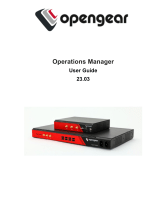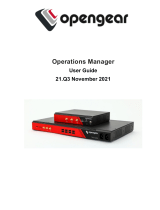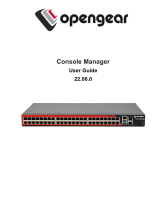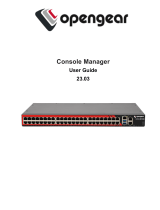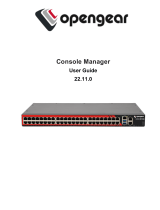Page is loading ...

Operations Manager
User Guide
21.Q1 March 2021

Contents
Copyright © 6
Safety & FCC Statement 7
About This User Guide 9
Installation And Connection 10
Power Connection 11
Dual AC Supply 13
Device Status LEDs 15
Connecting to the Network 17
Serial Connection 18
Cellular Connectivity 19
Reset and Erase 20
Initial System Configuration 21
Default Settings 22
Management Console Connection via CLI 24
Change the Root Password 25
Disable a Root User 27
MONITOR Menu 31
System Log 32
LLDP CDP Neighbors 33
Triggered Playbooks 34
ACCESS Menu 35
Local Terminal 36
Access Serial Ports 37

CONFIGURE Menu 40
Serial Ports 41
Local Management Consoles 45
Lighthouse Enrollment 47
Playbooks 49
PDUs 52
SNMP Alerts 54
SNMP Alerts System - Temperature, Authentication, Configuration 55
SNMP Alerts Power 58
SNMP Alerts Networking (Connection Status) 60
Network Connections 62
Network Interfaces 63
Dual SIM 64
Dual SIM Automatic Failover 70
Network Aggregates - Bonds and Bridges 76
Spanning Tree Protocol 82
IPsec Tunnels 85
Network Resilience 89
OOB Failover 90
IP Passthrough 91
User Management 92
Groups 93
Local Users 96
Remote Authentication 101
RemoteLocal for AAA Server 107
Local Password Policy 110
Services 115
HTTPS Certificate 116
Network Discovery Protocols 118

Routing 119
SSH 120
Unauthenticated SSH to Console Ports 122
Syslog 128
Remote Syslog 130
Session Settings 135
Firewall 136
Firewall Management 137
Interzone Polices 144
Services - Firewall 147
Date & Time 149
Time Zone 150
Manual Settings 151
Automatic Settings 152
System 153
Administration 155
Factory Reset 156
Reboot 157
System Upgrade 158
SNMP 159
SNMP Service 160
SNMP Alert Managers 161
Multiple SNMP Alert Managers 163
Advanced Options 166
Communicating With The Cellular Modem 167
OGCLI Guide 169
Docker 184
Cron 185
Initial Provisioning via USB Key 187

Copyright ©
Opengear Inc. 2020. All Rights Reserved.
Information in this document is subject to change without notice and does not rep-
resent a commitment on the part of Opengear. Opengear provides this document
“as is,” without warranty of any kind, expressed or implied, including, but not limited
to, the implied warranties of fitness or merchantability for a particular purpose.
Opengear may make improvements and/or changes in this manual or in the product
(s) and/or the program(s) described in this manual at any time. This product could
include technical inaccuracies or typographical errors. Changes are periodically
made to the information herein; these changes may be incorporated in new editions
of the publication.
COPYRIGHT © 6

Safety & FCC Statement
Safety Statement
Please take care to follow the safety precautions below when installing and oper-
ating the OPERATIONS MANAGER:
lDo not remove the metal covers. There are no operator serviceable com-
ponents inside. Opening or removing the cover may expose you to dangerous
voltage which may cause fire or electric shock. Refer all service to Opengear
qualified personnel.
lTo avoid electric shock the power cord protective grounding conductor must
be connected through to ground.
lAlways pull on the plug, not the cable, when disconnecting the power cord
from the socket.
Do not connect or disconnect the appliance during an electrical storm. Also use a
surge suppressor or UPS to protect the equipment from transients.
FCC Warning Statement
This device complies with Part 15 of the FCC rules. Operation of this device is sub-
ject to the following conditions: (1) This device may not cause harmful interference,
and (2) this device must accept any interference that may cause undesired oper-
ation.
Proper back-up systems and necessary safety devices should be utilized
to protect against injury, death or property damage due to system failure.
Such protection is the responsibility of the user.
SAFETY & FCC STATEMENT 7

This device is not approved for use as a life-support or medical system.
Any changes or modifications made to this device without the explicit
approval or consent of Opengear will void Opengear of any liability or
responsibility of injury or loss caused by any malfunction.
This equipment is for indoor use and all the communication wiring are lim-
ited to inside of the building.
SAFETY & FCC STATEMENT 8

About This User Guide
This user guide covers the Opengear Operation Manager products, including the
OM2200 family of rack-mountable appliances (available with combinations of up to
48 serial ports and 24 Ethernet ports) and the OM1200 family of small form-factor
appliances (available with combinations up to 8 serial and 8 Ethernet ports).
This manual is up to date for the 20.Q4 November 2020 firmware release. When
using a minor release there may or may not be a specific version of the user guide
for that release. The current Operations Manager user guide can always be found
here.
ABOUT THIS USER GUIDE 9

Installation And Connection
This section describes how to install the appliance hardware and connect it to con-
trolled devices.
INSTALLATION AND CONNECTION 10

Power Connection
OM2200 and some newer OM1200 have dual power inlets with auto failover built
in. These power supplies each accept AC input voltage between 100 and 240 VAC
with a frequency of 50 or 60 Hz. The OM2224-24E-10G-L draws a maximum of
48W, while non-24E are less than 30W.
Two IEC AC power sockets are located on the power side of the metal case, and
these IEC power inlets use conventional IEC AC power cords.
Note: Country specific IEC power cords are not included with OM2200s.
OM1200s are shipped with a 12VDC to universal AC (multi-country clips) wall
adapter.
See also "Dual AC Supply" on page13 and "SNMP Alerts Power" on page58.
Operations Manager Platform (OM1200) Environmental And Power
Power Draw < 25 Watts
Operating conditions Temperature 0~50C, Rel Humidity 5~90%
Cooling Passive
Environmental Sensors Smart Controller with multi-zone temperature
sensors.
Auto-shutdown/re-boot on severe thermal events
Power Draw Sensors Active multi-zone power draw monitoring
INSTALLATION AND CONNECTION 11

Operations Manager Platform (OM2200) Environmental And Power
Power Supply Dual AC or dual DC
Power Draw 48 Watts for -24E, others <30W
Operating conditions Temperature 0~50C, Rel Humidity 5~90%
Cooling Passive
Environmental Sensors Smart Controller with multi-zone temperature
sensors
Supervisory environmental controller with safety
power down.
Power Draw Sensors Active multi-zone power draw monitoring
INSTALLATION AND CONNECTION 12

Dual AC Supply
Dual AC Supply can provide power redundancy for devices, especially those that
may operate in harsher environments. A secondary power supply provides redund-
ancy for the device if one PSU is unplugged or in the event of a failure.
LED Power Status Indicator
The power LED indicator requires no configuration and will display the dual power
status on any Operations Manager device with a dual power supply.
On a device with a single PSU (power supply unit) or, a dual PSU device has
power connected to two PSUs, the LED power status indicator should be green at
all times.
If a dual PSU device has power connected to one PSU (power supply unit), the
LED power status indicator is colored orange indicating that the unit has no redund-
ancy in the event of a power failure.
INSTALLATION AND CONNECTION 13

SNMP Alerts for Power-related Events
The System Voltage Range SNMP alert is triggered when there is a change in
power status such as a system reboot or when the voltage on either power supply
leaves or enters the configured range of the System Voltage alert.
SNMP Alert Configuration
The System Voltage Range SNMP alert is configured in the Configure > SNMP
Alerts page, see "SNMP Alerts Power" on page58.
INSTALLATION AND CONNECTION 14

Device Status LEDs
The LED states shown below are determined through infod status and config-
server data. The config server holds a configurable threshold value for the Cell
LED Amber / Green light, and modem enabled / disabled information.
Status LEDs
LED Condition
LED Off Amber
Flashing Amber Solid Green
Flashing Green Solid
Power Device is off. On a dual
power supply
system:
Only one PSU
is connected.
On a single
power supply
system:
power is con-
nected.
On a dual
power supply
system:
Redundant
power is con-
nected.
Heartbeat Device has
halted.
Device is
booting.
Normal
operation.
Device is
halted.
Network No active net-
work con-
nection
Device is fail-
over starting.
Device is in
failover.
Normal net-
work con-
nection is
stopping or nor-
mal network is
up and failover
is stopping.
Network is
connected.
INSTALLATION AND CONNECTION 15

Status LEDs (continued).
LED Condition
LED Off Amber
Flashing Amber Solid Green
Flashing Green Solid
Cellular
Interface
Cellular is not
in use.
Cell is start-
ing and sig-
nal is
below
threshold.
The LED
signal
threshold
config is set
to 50%.
Cell is con-
nected and
signal is
below
threshold. The
LED signal
threshold con-
fig is set to
50%.
Cell is starting
and signal is
above, or equal
to the
threshold.
Cell is con-
nected and
signal is
above, or
equal to the
threshold.
IOIO Any serial activ-
ity is received,
on either con-
sole/usb con-
sole or device
serial ports.
Cloud /
Internet
Not implemented.
Note: The amber LED signal threshold config is set to 50%.of normal signal
strength.
For information on the setting of network and power alert thresholds, see:
"SNMP Alerts Networking (Connection Status)" on page60
"SNMP Alerts Power" on page58
INSTALLATION AND CONNECTION 16

Connecting to the Network
All Operations Manager products have two network connections labeled NET1 and
NET2. In the OM2200, there are options for copper wiring (on a standard RJ-45 con-
nector) and fiber (through a standard SFP module).
The network connections on the OM2200 are located on the serial port side of the
unit. Connect the provided shielded CAT5 cable to the NET1 to a computer or into
your network for initial configuration. By default NET1 and NET2 are enabled.
You can use either 10/100/1000BaseT over Cat5 or fiber-optical transceiver
(1Gbps) in the SFP slot for NET1 or NET2 on OM2200 (non-10G) and OM1208-8E.
INSTALLATION AND CONNECTION 17

Serial Connection
The serial connections feature RS-232 with software selectable pin outs (Cisco
straight –X2 or Cisco reversed –X1). Connect serial devices with the appropriate
STP cables.
INSTALLATION AND CONNECTION 18

Cellular Connectivity
The Operations Manager products offer an optional global cellular LTE interface
(models with -L suffix). The cellular interface is certified for global deployments with
most carriers and provides a CAT12 LTE interface supporting most frequencies in
use. To activate the cellular interface, you should contact your local cellular carrier
and activate a data plan associated to the SIM installed.
For -L models, attach the 4G cellular antennas to the unit’s SMA antenna sockets
on the power face (or to the extension RF cables) before powering on. Insert the
2FF SIM card on the power face with the contact facing up. Use the left SIM socket
first.
Installing A New SIM Card
Before installing a new SIM card, the OM device must first be powered down. This
can be done by switching off the power supply and waiting until the device has
shut-down. Install the new SIM card into its slot, then restart the device
Note: The device will not recognize the new SIM card unless a shut-down and
restart is performed. The new SIM card will be read during start-up.
INSTALLATION AND CONNECTION 19

Reset and Erase
CONFIGURE > System > Reboot
The OPERATIONS MANAGER reboots with all settings (e.g. the assigned network
IP address) preserved.
To reboot the unit:
Select CONFIGURE > System > Reboot.
To erase the unit:
Push the Erase button on the port-side panel twice with a bent paper clip while the
unit is powered on.
This resets the appliance to its factory default settings. Any modified configuration
information is erased. You will be prompted to log in and must enter the default
administration username and administration password (Username: root Password:
default). You will be required to change this password during the first log in.
INSTALLATION AND CONNECTION 20
/

